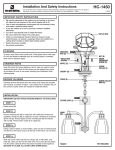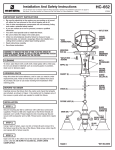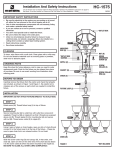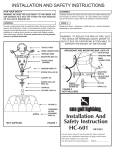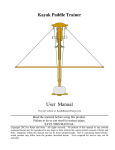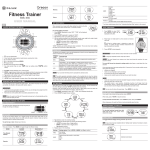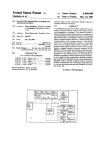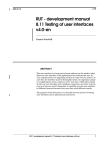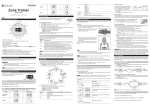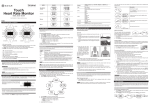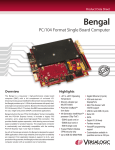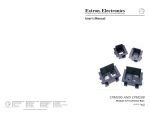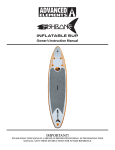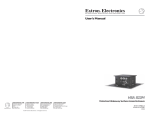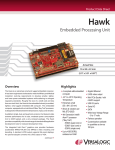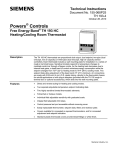Download Mini Paddle Trainer User Manual – PDF
Transcript
Mini Paddle Trainer Mini Paddle Trainer Performance Force (Lb.) Time (m:s) Speed (mph) Distance (mi) Power (W) Energy (Cal) Cad. (SPM) Strokes On / Off User Manual Visit our website at: KayakBalanceTrainer.com Read the material before using this product. Failure to do so can result in serious injury. SAVE THIS MANUAL. Copyright 2012-2015 by Korpi and Sons, Inc. All rights reserved. No portion of this manual or any artwork contained herein may be reproduced in any shape or form without the express written consent of Korpi and Sons, Inc. Diagrams within this manual may not be drawn proportionally. Due to continuing improvements, actual product may differ from the product described herein. Tools required for service may not be included. 1 Name ______________________________ Purchase Date ___________ Serial Number ________ INTRODUCTION The Mini Paddle Trainer (MPT) is an adaptive core strength builder designed for people who want the option of using their own chair, even people who use wheelchairs will find the MPT an excellent way to exercise. People learning how to kayak or paddle a stand up paddleboard will find the MPT a fun way to train without having to get into the water. The MPT is also an excellent alternative for training during bad weather to maintain the core and upper body strength needed for successful watersporting. The MPT provides the exerciser with paddle strokes that mimic the on water experience. The MPT is fully adjustable to accommodate a wide range of exercisers depending on their strength and individual preferences such as sitting for kayak training and standing for paddleboard training. The wall-mounted exerciser requires a minimal amount of space when not in use. Each MPT is hand built in America by wood craftspeople. 1. The wall-mounted base is made of natural cedar clear coated to allow the wood grain to come through. 2. The paddle is made from ash a hardwood known for strength and durability. 3. The flywheel is designed to maximize glide time that closely mimics the on water gliding feeling. 4. Adjustable settings allow for a wide range of force needed for various paddlers capabilities and may be increased as strength is built up. 5. The wall trainer is designed with a smooth, durable and reliable rope drive mechanism. SAVE THIS MANUAL You will need this manual for the safety warnings and precautions, operating, inspection, maintenance and cleaning procedures, parts list and assembly diagram. Keep your invoice with this manual. Keep this manual and invoice in a safe and dry place for future reference. 2 PRODUCT SPECIFICATIONS Power produced Dimensions Weight Designed use Display Intensity Drive type Power requirements Materials Frame Rope Pulley blocks Up to 250W at max pulling force Wall unit: 20”L x 7”W x 10”H, Paddle: 61” 12 pounds Consumer Pulling Force (pounds); Paddling time (Minutes:Seconds); Velocity (Miles/hour); Distance (Miles); Power (Watts); Energy (calories) Cadence (Strokes/Minute), Stroke Count Variable setting of pulling force using nylon cord on flywheel Rope and drive pulley to spin flywheel 2 batteries type CR123, included Finished wood 5/16” braided synthetic fiber Marine low friction GENERAL SAFETY RULES AND PRECAUTIONS WARNING: Read the following important precautions and information before using the Mini Paddle Trainer. - Exercise can present a health risk; consult with a physician before beginning any exercise program with this equipment. - Warming up and stretching before and after a workout will help minimize the risk of injuries. - Maintain a clear area of 3.5 to 4 feet on the sides and back of the trainer for an unobstructed paddle stroke. - Use a firm grasp on the flywheel and frame while lifting and moving the trainer. Do not lift the unit by the ropes or pulleys as these may shift position causing you to drop the unit or pinch your fingers. - Use the trainer on a flat, level, sturdy surface, away from moisture and dust. Do not store the trainer in a damp area or covered patio, or near water. - The user may remain standing or seated while operating the trainer. - Increase the duration and intensity of exercise in small increments to avoid muscle strain and soreness. - If you feel faint or dizzy, immediately discontinue use of this equipment. - Watch what you are doing, and use caution and common sense while exercising. Do not use the trainer while under the influence of drugs, alcohol or medication. 3 - Keep other people and pets away from the trainer when in use. - Always make sure screws and attachments are secured tightly prior to each use. Inspect and replace any frayed cords, rubber bands and rope. - Do not attempt to use your trainer for any purpose other than the purpose for which it is intended. ASSEMBLY INSTRUCTIONS The unit has been partially disassembled for shipment in two boxes. The long mailing tube contains the paddle and the rectangular box contains the rest of the unit. 1. Locate a clear area of roughly 6 foot square that will not interfere with the paddling motion. 2. Remove all items from the boxes. 3. The MPT is supplied with 2 each – ¼ x 3” lag bolts and washers to facilitate mounting the unit to a plasterboard wall. If you are mounting to another type of wall - cement, cinder block etc please consult your local hardware store for appropriate mounting hardware. 4. For plasterboard walls: a. Use a stud finder to locate the wall studs. Standard construction has stud spacing of 16” with center-to-center spacing between studs. Select the stud with adequate area to swing the paddle. Mark the stud location on the wall. Position the Mini Trainer approximately 2-14 inches off of the floor; it can be positioned immediately above the floor molding or baseboard radiators. Use a support to rest the trainer on, so that it does not shift while marking the drill spots. Make sure the mounting holes align with the stud and the unit is vertical. Mark the positions of the two mounting holes with a center tap or Phillips screwdriver. b. Remove the unit and drill two 316” pilot holes at the marked points. c. Re-position the unit back in place and install the two lag bolts with washers. Tighten mounting hardware. d. Mark a position on the same stud approximately 6 to 7 feet off the floor. Drill a 5/32” pilot hole at this point. Screw the swage hook into the wall at this point. e. Connect the upper pulley bungee cord to the swag hook. f. Remove the two Performance Monitor (PM) mounting screws from the top of the main unit. Use these screws to mount the PM to the main unit. Plug the RJ12 cable from the magnetic pickup into the bottom of the PM. 5. Attach the rope ends to the paddle grooves; pull the rope tight so the slipknot makes a tight fit in the paddle grooves. 6. Adjust the flywheel resistance force as follows: Press the cord clamp release button on the top of the PM and pull up the cord slightly to remove pressure of the cord on the flywheel. Paddle a few easy strokes to accelerate the flywheel to a moderate speed. Pull up on the cord so that the flywheel is slowing gradually and set the cord clamp to this position. A light force slows the flywheel to a stop in about 20 seconds, a heavy force stops it in less 4 than 3 seconds. Adjust the flywheel force so the resistive force is comfortable for you. We recommend setting at a light force when starting out. 7. Adjust the swage hook bungee length as follows. Press the cord clamp release button on bungee to shorten or lengthen the distance between the swag hook and the upper pulley. This bungee adjusts the tension of the rope on the drive pulleys. To increase rope tension, either shorten the bungee or move back slightly from the trainer. To decrease rope tension, either lengthen the bungee or move slightly closer to the trainer. 8. Turn on the PM power switch. You are ready to paddle. PERFORMANCE MONITOR Mini Paddle Trainer Performance Force (Lb.) Time (m:s) Speed (mph) Distance (mi) Power (W) Energy (Cal) Cad. (SPM) Strokes On / Off Basics The Performance Monitor is used to provide feedback on eight different factors that indicate the level of performance being exerted by the athelete. There are four LED lights that light up corresponding to the specific factor being displayed. The LEDs light up yellow to indicate factors in the yellow box or red to indicate factors in the red box; for example, when the third LED lights up red, the factor being displayed is Energy in calories. The eight factors are displayed in turn in a cycle that takes 30 seconds and then repeats itself. If the flywheel stops rotating for more than 4 minutes, the power turns off to conserve battery energy. When the flywheel stops, the factors on the left side, the “yellow” factors read zero, 5 while the “red” factors maintain their accumulated values. If the athlete resumes paddling before power turns off, the measurements continue as if the flywheel had not stopped. Torque Static torque is a balance of forces about an axis or axle with no movement. Consider a sea saw. The torque “T” is a product of force “F” at a distance “D”. The sea saw is balanced when the torque is equal on each side, for example: 100 pounds at 6 feet from the balance point with 60 pounds at 10 feet on the other side. 100# x 6’ = 600 foot-pounds on one side equals 60# x 10’ = 600 foot pounds on the other side balancing the sea saw. Torque(T) = Force(F) x distance(D) 6 feet 10 feet 100 pounds 60 pounds Dynamic torque is an un-balanced force about an axis or axle that causes a rotational movement. Consider a flywheel mounted on an axle with a string wrapped around the perimeter or outside of the flywheel. A weight on the string produces a constant force “F” such that a force at a distance “D” from the center of the axle will cause a torque “T” to be applied to the flywheel and cause it to rotate. The changing rotational speed “RPM” is a RPM = Kf x Torque(T) x time(t) bearing D bearing Force Torque(T) = Force(F) x distance(D) product of the flywheel inertial mass “Kf” times torque “T” times time “t”. For a given flywheel the RPM will change more with increased torque or more time. The amount of time is longer to reach the desired RPM if the flywheel is larger. 6 Average Paddle Force Right Stroke Left Stroke Right Stroke Left Stroke Right Stroke time 0 Resistive Force + time 0 RPM time 0 In flywheel based exercise equipment the intermittent force pulses generated by the athlete are smoothed out or averaged by the flywheel. The average force is shown by the dotted line. The resistive or breaking force is of equal magnitude but opposite direction to the average athletic force and therefore balanced out when the athlete paddles at a constant speed. Performance Measurements A small computer is used to monitor a magnetic pickup that generates pulses whenever a flywheel magnet passes the pickup. The computer calculates several factors and displays performance information for the athlete. These factors are explained below. 1. Flywheel Speed: The computer uses a high speed counter to accurately measure the time between each pickup signal pulse indicating the period of rotation of the flywheel. This time is inversely proportional to the RPM of the flywheel: RPM = 60 / period(sec). For example if the flywheel period measures 0.050 sec then the RPM is 60/0.050 = 1200 RPM. The RPM factor is used in the formulas below to produce performance information. 2. Cadence: The cadence is the stroke rate in Strokes Per Minute (SPM) of the athlete. The computer monitors the RPM parameter and stores the maximum and minimum RPM values to determine when a stroke is taking place. It measures the time between RPM maximums i.e. the stroke period to determine stroke rate: SPM = 60 / stroke period (sec). For example if the stroke period measures 0.75 second then the cadence is 60/0.75 = 80 SPM. 3. Stroke Counter: The stroke counter starts at zero and increments each time a stroke is detected. It counts the total strokes of a workout session. 7 4. Pulling Force: The average stroke pulling force is equal to the average breaking force caused by a cord around the flywheel. The amount of resistive or slowing torque may be measured by measuring the time it takes to slow down using the formula: change in RPM = Kf x Torque x time as presented earlier. The amount of resistive torque may be accurately measured by comparing the time for one flywheel rotation compared to the time of the previous rotation while the flywheel RPM is slowing down. The accelerating torque is similarly calculated while the flywheel is speeding up. During the forward stroke, the athlete supplies the torque to accelerate the flywheel plus the torque to overcome the resistive torque of the braking cord. The pulling force is the sum of the torques divided by the radius of the drive pulley. 5. Average Power: The average power produced by the athlete is calculated from the formula: Power (W)= 0.01183 x Average Torque(T) x RPM where average torque is in inch-pounds and power is in Watts. This parameter indicated the level of effort expended by the athlete. 6. Energy: The energy data indicates the calories that were used during the workout session. The calories are equal to the average power times time: Calories (C) = 5 x Power (W) x time (hour). Thus if you exercise for 1 hour at a 100Watt power level the computer estimates 500 calories were used. The actual calories used, however, varies considerably based on athletes weight, cardiovascular condition, conditioning of the muscle groups and technique. 7. Velocity: The velocity or speed parameter indicates the velocity of a boat on the water. The power needed to produce velocity is an exponential curve; see below. The formula is: Velocity = Kv * (Power) ^ 1/3 where Kv, for narrow watercraft, is 2.8 meter/sec or 1.585 MPH. For example when power = 256W or about 1/3 HP; Velocity = 1.585 x (256) ^ 1/3 equals 10.04 mph as shown on the graph. This power vs. velocity curve is stored in the computer and the velocity parameter is generated from this curve. 12 10 8 Speed (MPH) 6 4 2 0 01 5 9 13 17 21 25 29 33(W) 37 Power 41 45 49 53 57 61 256 8. Distance: The distance parameter indicates the distance traveled by the boat. The distance is calculated by multiplying the velocity factor by time. 8 9. Time: The time parameter indicates the duration of the workout session and is produced by the computer clock whenever the computer detects that the athlete is providing power to the flywheel. OPERATING INSTRUCTIONS 1. Take a few minutes to warm-up and stretch your body. 2. Take your position in front of the trainer with feet on the floor and slowly move the paddle shaft in a wide controlled stroke to see that there are no obstructions to a full paddle movement. Reposition yourself or move objects as necessary so an unobstructed stroke is obtained. 3. Adjust the bungee cord and flywheel resistance settings if necessary, reference directions in the assembly instruction section. 4. Use proper paddling posture and technique to prevent common muscle and joint injuries. Sit with an upright or slightly leaning forward posture. Rely on your core muscles and not just your arm muscles for power. Start by holding the paddle at arms length with your arms parallel at shoulder width. If you lock your elbows you will find the only way to paddle is to rotate your torso and use your core muscles. Then, bend your elbows slightly and continue the same motion with your arms transferring the power from the core to the push and pull motion of the paddle. 5. Paddle at the desired cadence and duration to your liking and comparable to on water exercise. 6. After paddling, take a few minutes to cool down and stretch again. WARM-UP AND COOL DOWN Warm-Up The purpose of warming up is to prepare your body for exercise and to minimize injuries. Warm up for two to five minutes before strength training or aerobic exercising. Perform activities that raise your heart rate and warm the working muscles. Activities may include brisk walking, jogging, jumping jacks, jump rope and running in place. Stretching Stretching while your muscles are warm after a proper warm-up and again after your strength or aerobic training session is very important. Muscles stretch more easily at these times because of their elevated temperature, which greatly reduces the risk of injury. Stretches should be held for 15 to 30 seconds. Do not bounce. Remember to always check with your physician before starting any exercise program. 9 Cool-Down The purpose of cooling down is to return the body back to its normal, or near normal, resting state at the end of each exercise session. A proper cool-down slowly lowers the heart rate and allows blood to return to the heart. The cool-down should include stretches after each training session. EXERCISE GUIDELINES Base your exercise program on your physical condition. If you have been inactive for several years or are severely overweight, start slowly and increase your workout time gradually. Increase your workout duration and intensity gradually by monitoring your heart rate while you exercise. Initially you may only be able to exercise within your target zone for a few minutes. As you continue exercising, your aerobic capacity will improve over a period of 6-8 weeks. It is important to pace yourself while you exercise so you don’t tire too quickly. For cardio respiratory training benefits, the American Heart Association recommends working out at a Target Heart Rate Zone of between 60% and 75% of your maximum heart rate based on age. To predict your maximum heart rate, use the formula 220-Age = maximum heart rate. For example, if you are 40 years old, your max rate is: 220-40 = 180. Your exercise heart rate range is then 0.6x180=108 to 0.75x180=135 beats per minute. If just starting out, work out at the low end of your target heart rate zone. As your aerobic capacity improves, gradually increase the intensity of your workout by increasing your heart rate. Measure your heart rate periodically during your workout with a heart rate monitor or by counting the number of heart beats for six seconds and multiplying the number by 10 to get your heart rate. For example if your six second heartbeat count is 15, your heart rate is 150 beats per minute. Adjust your exercise intensity such that your heart rate is within proper range for your age. TRAINER INSPECTION, MAINTENANCE AND CLEANING 1. Before each use, inspect the general condition of the trainer. Check for loose screws, misalignment or binding of moving parts, frayed rubber bands rope or cords, cracked or broken parts and any condition that may affect the safe use of the trainer. Do not use the trainer if it is damaged; have the problem corrected before further use. 2. To clean, wipe with a damp cloth, using a mild detergent. Never use solvents such as alcohol, trichloroethylene, etc on the trainer. 3. If the rollers do not spin freely, it may be necessary to lubricate the main axle. Any light machine oil may be used. Apply oil sparingly to space between the shaft collar and the drive pulley. Be careful not to get any oil on the pulley v-groove or the rope. If this happens, the rope will fail to grip the roller. If oil gets on the roller, it must be cleaned. If oil gets on the rope it may have to be replaced. 10 PLEASE READ THE FOLLOWING CAREFULLY THE MANUFACTURER AND/OR DISTRIBUTOR HAS PROVIDED THE PARTS LIST AND LOCATION DIAGRAM IN THIS MANUAL AS A REFERENCE TOOL ONLY. NEITHER THE MANUFACTURER OR DISTRIBUTOR MAKES ANY REPRESENTATION OR WARRANTY OF ANY KIND TO THE BUYER THAT HE OR SHE IS QUALIFIED TO REPLACE ANY PARTS OF THE PRODUCT. IN FACT, THE MANUFACTURER AND/OR DISTRIBUTOR EXPRESSLY STATES THAT ALL REPAIRS AND PARTS REPLACEMENTS SHOLD BE UNDERTAKEN BY CERTIFIED AND LICENSED TECHNICIANS, AND NOT BY THE BUYER. THE BUYER ASSUMES ALL RISKS AND LIABILITY ARISING OUT OF HIS OR HER REPAIRS TO THE ORIGINAL PRODUCT OR REPLACEMENT PARTS THERETO, OR ARISING OUT OF HIS OR HER INSTALLATION OR REPLACEMENTS PARTS THERETO. PARTS LIST Part 1 2 3 4 5 6 7 8 9 Description Flywheel 5/16” rope Paddle shaft Drive pulley Rope guide pulley Rope fairlead guide Performance meter Swag hook Flywheel braking cord No. Part Description 015-01 10 Upper pulley 015-02 11 Axle 015-03 12 Bungee cord 015-04 13 Shaft collar 015-05 14 Frame 015-06 15 Cord lock 015-07 16 Mounting hardware 015-08 17 Magnetic pickup 015-09 18 Drive pulley band Note: Some parts are listed and shown for illustration purposes only, and are not available individually as replacement parts. 11 No. 015-10 015-11 015-12 015-13 015-14 015-15 015-16 015-17 015-18 LOCATION DIAGRAM 8 15 12 10 7 Paddle Mini Trainer Performance 6 Force (Lb.) Time (m:s) Speed (mph) Distance (mi) Power (W) Energy (Cal) Cad. (SPM) Strokes 17 On / Off 5 13 11 4 1 9 16 14 2 3 12 WARRANTY Korpi and Sons, Inc. makes every effort to assure that its products meet high quality and durability standards and warrants to the original purchaser that for a period of ninety days from the date of purchase that the motor/generator, the belts and rope are free of defects in materials and workmanship. Korpi and Sons, Inc. also warrants to the original purchaser, for a period of one year from the date of purchase, that all other parts and components of the product are free from defects in materials and workmanship (90 days if used as common gym equipment; for example in a school, exercise club or as rental equipment). This warranty does not apply to damage due directly or indirectly, to misuse, abuse, negligence or accidents, repairs or alterations outside our facilities, normal wear and tear, or lack of maintenance. We shall in no event be liable for death, injuries to persons or property, or for incidental, contingent, special or consequential damages arising from the use of our product. Some states do not allow the exclusion or limitation of incidental or consequential damages, so the above limitation of exclusion may not apply to you. THIS WARRANTY IS EXPRESSLY IN LIEU OF ALL OTHER WARRANTIES, EXPRESS OR IMPLIED, INCLUDING THE WARRANTIES OF MERCHANTABILITY AND FITNESS. To take advantage of this warranty, the product or part must be returned to us with transportation charges prepaid. Proof of purchase date and an explanation of the complaint must accompany the merchandise. If our inspection verifies the defect, we will either repair or replace the product at our election or we may elect to refund the purchase price if we cannot readily and quickly provide you with a replacement. We will return repaired products at our expense, but if we determine there is no defect, or that the defect resulted from causes not within the scope of our warranty, then you must bear the cost of returning the product. This warranty gives you specific legal rights and you may also have other rights, which vary from state to state. Kayak Paddle Trainer, PO Box 1161 – Syosset, NY 11791 – [email protected] 13














